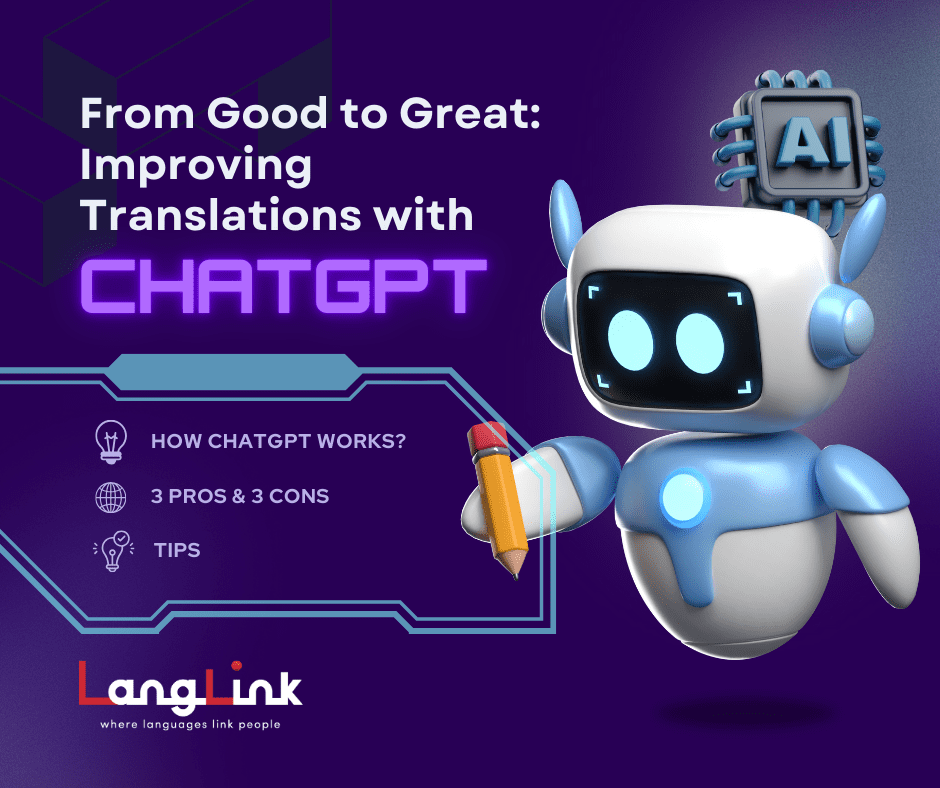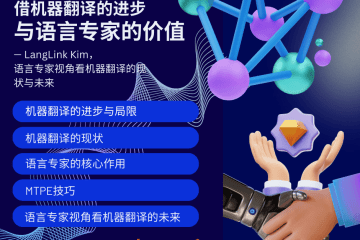借助AI变革翻译之旅:使用ChatGPT提升翻译质量的最佳实践

随着人工智能技术的不断进步,越来越多的翻译老师开始使用 AI 翻译工具来提升效率和质量。其中,ChatGPT 因其强大的语言处理能力,备受语言服务从业者的青睐。不少企业也借助 ChatGPT 提供由 AI 驱动的本地化服务,简化流程并专注于提升翻译质量。
无论您是刚开始接触 ChatGPT,还是希望充分挖掘其潜力,这篇文章都将为您提供宝贵的见解与实用技巧。细细阅读,一起探索如何让 ChatGPT 变革您的翻译之旅!
ChatGPT 的工作原理
要充分利用 ChatGPT,首先需要了解它的核心机制。ChatGPT 是基于大规模语言模型开发的,ChatGPT 从大量的文本数据中学习,从而推断书籍、文章和在线内容等不同资料来源中的字词之间的关系。
凭借这一强大的语言处理能力,ChatGPT 能够协助用户理解复杂概念,提供结构清晰、语法正确的回复,同时快速生成参考译文。因此,我们很有必要探索如何利用 ChatGPT 进行翻译,尤其是如何借助 ChatGPT 简化翻译流程。但是,我们不应将 ChatGPT 与搜索引擎混为一谈,因为ChatGPT是根据训练数据中的模式生成输出结果,而非从网络获取实时或具体的信息。
与此同时,我们也需要了解ChatGPT 的局限性。ChatGPT 的劣势在于,需要依赖预先学习的字词联想功能提供回复,因此在处理需要真正创造力或创新性的任务时稍显逊色。ChatGPT根据现有模式生成回复,但无法脱离所学数据来生成全新的思维或原创性的表达。
因此,ChatGPT 在翻译领域的表现如何,ChatGPT生成的翻译质量如何,需要具体情况具体分析。为了更好地理解ChatGPT在翻译语言处理任务中的优缺点,我们将通过以下实例展开进一步探讨。
ChatGPT的优点 1:快速提供翻译建议
通过输入简单的提示词,例如:
将这句话翻译成(目标语言)
Translate this sentence into \[target language]
ChatGPT 可以快速生成译文。但需要注意,这些译文有时可能不够准确、流畅或连贯。为提升翻译质量,您可以向 ChatGPT 提供更多语境信息,例如目标受众、句子主旨以及期望的语气和风格。这种方法是改进 AI 翻译质量的关键策略之一,利用这种方法,ChatGPT 的翻译质量能够得到显著提高,尤其是必须遵守严格风格指南要求的专业译文。
ChatGPT的优点 2:解释概念和总结观点
ChatGPT 擅长总结冗长的文章和文件,可以将内容转化为简明扼要的概述并突出主旨,以便读者轻松理解。这项功能对于翻译老师来说尤为实用,能帮助他们快速理解翻译材料的整体背景信息和相关参考资料。即使面对复杂的商业术语或技术术语,ChatGPT 生成的总结也能协助翻译老师更轻松地处理难度较大的内容。因此,这项功能显著提高了翻译老师的工作效率,使 ChatGPT 成为翻译老师借助 AI 提升翻译质量的有效工具。
这些优点对于在全球项目中创建多语言沟通解决方案也至关重要。通过解释和总结任务的背景信息,ChatGPT 有助于确保负责不同地区工作的团队对任务要求形成一致理解,从而使各个市场提供风格一致的译文,传达客户一致的品牌形象。
ChatGPT的优点 3:持续输出语法正确的内容
ChatGPT 另一显著优点是持续输出语法正确的内容。。这种可靠性对于翻译老师来说尤为重要,因为他们可以使用ChatGPT来检查语法错误。例如,如果要对“许多人担心社会会继续歧视少数民族”这句原文的译文“Many people concern that society will continue to discriminate minors”进行分析,用户可以在 ChatGPT 中输入以下提示词:
请参考原文“许多人担心社会会继续歧视少数民族”,指出和说明以下句子中的语法错误,并予以更正。请勿进行不必要的修改。
ChatGPT 会找出句子中的错误,例如句中错误地使用了“concern”,应改为“are concerned”,以及“minors”一词在该语境下不恰当。最终,ChatGPT 提供以下的修改版译文:“Many people are concerned that society will continue to discriminate against minority groups.”这个示例充分说明了什么是精确语言处理,并展示了 ChatGPT 如何提升翻译准确性和整体翻译质量。
ChatGPT的缺点 1:无法像搜索引擎一样执行准确搜索
虽然 ChatGPT 是一款实用的翻译辅助工具,但需要注意的是,它在搜索准确性和范围方面均不及传统搜索引擎。搜索引擎会抓取网络内容,并根据各种资料来源提供实时搜索结果,而 ChatGPT 则是依靠固定数据集来生成回复,这可能会限制ChatGPT的回复效果。例如,如果用户查询“舒式猪齿鱼”的英文通用名,Google 等搜索引擎会给出正确答案“Blackspot Tuskfish”。但 ChatGPT 却可能提供错误的名称,如“Sheepshead”或“Schneider’s Pygmy Tetra”。ChatGPT提供的这两种翻译都不正确,“Sheepshead”是完全不同的物种,而“Schneider’s Pygmy Tetra”则是无中生有的名称。这种局限性表明,虽然 ChatGPT 可以生成包含有用信息的回复,但不一定总能提供正确或关联度最高的信息,在检索专业术语或处理特定查询时更是如此,而这可能会影响 ChatGPT 的翻译准确性。
ChatGPT的缺点 2:缺乏创造力和创新性
尽管 ChatGPT 在生成连贯、语境适配的文本内容方面表现出色,但它通常缺乏人类思维和表达中特有的创造力和创新性。这是因为 ChatGPT 基于训练数据中的既定模式和示例运行,无法脱离所学数据生成全新的创意或具有高度独特性的表达。因此,其生成的内容可能显得较为公式化,难以满足某些场景下对创新性的高要求。例如,翻译老师尝试使用 ChatGPT 翻译“This headphone case is part of the Disney Eats Collection and is an earristible accessory that fans of the burger will relish”这句话时,可能会输入以下提示词:
将这句话翻译为简体中文:This headphone case is part of the Disney Eats Collection and is an earristible accessory that fans of the burger will relish.
参考资料:这是迪士尼产品描述,译文应符合迪士尼风格,而且生动有趣,能够吸引顾客购买产品。
然而,ChatGPT 可能会提供以下译文:这款耳机盒是迪士尼美食系列的一部分,是一个令人垂涎的配饰,汉堡迷们一定会喜爱。这句译文缺乏本地化处理,听起来不自然,并且未能体现俏皮的双关语“earristible”。为了解决这一问题,翻译老师可以通过为 ChatGPT 提供更具体的提示词来激发创造力比如为:
提供 10 个意思为“irresistible”的中文形容词和成语
这样一来,翻译老师就能从结果中选择心仪的表达。最终,ChatGPT 提供了更富创造力的译文:这款迪士尼 Eats 系列耳机盒套绝对叫汉堡迷难“耳”抗拒!这个示例说明,ChatGPT 可以提供基础性的帮助,但可能需要接收人工输入的额外信息,才能达到翻译工作中经常需要的创造性和细节把控水准。
在提升机器学习翻译质量与发挥人类创造力之间找到平衡,是将 ChatGPT 应用于语言本地化翻译项目中取得最佳效果的关键。
借助 ChatGPT生成最佳译文建议的技巧
借助 ChatGPT生成最佳译文建议,确保输入的提示词清晰具体非常重要。使用“指出”“列出”或“解释”这样明确的指引词语,能够帮助 ChatGPT 生成更准确和相关的译文。清晰的提示词不仅能提高输出质量,还能让用户在语言工作中更好地掌握细微差异和语境。这些 AI 翻译最佳做法有助于高效修改整体内容,遵循这些做法能显著提升译文质量,同时充分发挥AI翻译技术的潜能。
借助AI的力量变革您的内容发布之旅
在翻译工作中使用 ChatGPT可以让翻译老师充分发挥这款强大工具的潜能。通过输入清晰明确的提示词并反复训练,翻译老师可以获得高品质的翻译建议和灵感激发,提升翻译质量,输出准确出色的译文。ChatGPT正在快速变革语言服务从业者的工作流程和思维。而语言服务企业也不例外!
LangLink 致力于为客户提供卓越的本地化和翻译服务,为您量身打造满足多样化需求的本地化和内容创作解决方案。我们的团队始终秉持持续学习与创新的精神,紧跟技术发展前沿,善用 ChatGPT 等智能工具,为客户提供触动受众、引发共鸣的内容转换。
快与我们携手,借助AI的力量变革您的内容发布之旅吧!


